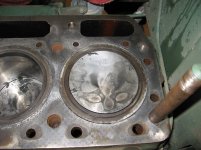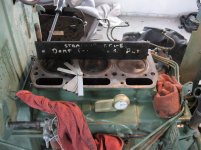You are using an out of date browser. It may not display this or other websites correctly.
You should upgrade or use an alternative browser.
You should upgrade or use an alternative browser.
Engine Piston Height
- Thread starter dalehowe
- Start date
/ Engine Piston Height
#11
284 International
Veteran Member
- Joined
- Jun 28, 2010
- Messages
- 1,466
- Tractor
- International Harvester 284
Do you think the resized rods are causing the pistons to protrude too far? I'm surprised there isn't a specification somewhere for this dimension.
I appreciate the come back on that. I' m thinking of have the tops of my piston
taken done to height of the top of the liners.
What you must be joking????
Here is a pic of my engine when I had it down sorry I didn't measure the actual piston height for posterity and it doesn't show a side view.
I knew it had to be ok because it ran fine up till the HG blew which was the engine builders (hack) mistake of not checking or letting it slide the fact the head was out .009".
It is common btw for diesels to have pistons above the deck/liners that is how you get 20+ to 1 compression.
I had to turn the crank so the pistons were down to measure my liner heights (that what I am doing in the one pic) because the pistons are above the liners like I mentioned .019" sounded ok to me that you say yours are.
Attachments
shawnjvl
Silver Member
When I had my 2000 apart, I seem to remember the pistons were definitely above the deck.
careyo63
Veteran Member
- Joined
- Jan 6, 2012
- Messages
- 2,059
- Tractor
- 77 Yanmar YM2000 63 Ford 2000
It is common btw for diesels to have pistons above the deck/liners that is how you get 20+ to 1 compression.
It's the Rings and how close they are coming out of the Cyl. is what I would be concerned about the most and or if the Head has been Milled. A machined head ground to much is what usually causes a piston it to hit a valve. and If there was a problem with the Cyl. being to high with the Ultra close Tolerances I seriously doubt the Head would Torque or Seat properly.
We have to keep valve timing in mind these diesels have pretty lazy valve timing and dont need very aggressive cams to run right and to be able to make the high compression they do and have to have to live.
The 4 cycle diesel operates different than 4 cycle gas and as such doesn't need a bunch of added valve timing to get a complete burn/full cylinder at higher speeds gas engines run at.
The possibility of a valve hitting a piston is slim to none still after .010-.020 is taken off imho just because the valves are not open anywhere near TDC.
My experience with Yanmar is limited to my tractor but his 336 is basically the same and my valves were below the head deck by a fair amount and after grinding valves and seats its even further under the deck. So thats why I believe they will never touch, if they were above the head deck which I doubt they are the story may be different. fwtw (my pre-chambers were above the deck by a good bit and Id say better than .020 just for conversation they never hit before or after milling and is the main reason I added an extra copper seal ring)
Consider our compression releases for instance...they hold the exhaust valve open all the way thru the cycle granted you could possibly adjust them enough so they hit but you take the cam out of the equation and hold them open is what I am getting at there.
And dont get me wrong I dont have facts to back that up just my gut feelings knowing engine manufacturers as well as I do.
The 4 cycle diesel operates different than 4 cycle gas and as such doesn't need a bunch of added valve timing to get a complete burn/full cylinder at higher speeds gas engines run at.
The possibility of a valve hitting a piston is slim to none still after .010-.020 is taken off imho just because the valves are not open anywhere near TDC.
My experience with Yanmar is limited to my tractor but his 336 is basically the same and my valves were below the head deck by a fair amount and after grinding valves and seats its even further under the deck. So thats why I believe they will never touch, if they were above the head deck which I doubt they are the story may be different. fwtw (my pre-chambers were above the deck by a good bit and Id say better than .020 just for conversation they never hit before or after milling and is the main reason I added an extra copper seal ring)
Consider our compression releases for instance...they hold the exhaust valve open all the way thru the cycle granted you could possibly adjust them enough so they hit but you take the cam out of the equation and hold them open is what I am getting at there.
And dont get me wrong I dont have facts to back that up just my gut feelings knowing engine manufacturers as well as I do.
Last edited:
Minimum quench distance on a high performance automotive gas engine is 35 to 40 thou. Factory tolerance is usually between 60 and 100 thou., but with stricter emissions and higher compression ratios this number is closer to the 35 number.
These little diesels run much tighter than that because of the limited rpm they see and the small bore. Personally I would go no tighter than 20 thou.
You can absolutely have the pistons tops milled, if you determine you do not have enough clearance. It's done all the time. It is up to you to take the proper measurements though, and use the compressed thickness of your head gasket for your calculations.
If it's strictly for the prechamber interference, you can clearance the piston with a dremel and a steady hand. You're only taking the equivalent of the amount of head milling that was done, which is easily achieved.
As to the question about the rod reconditioning changing the piston height, If the job is done correctly the center to center dimension of the rod does not change. Therefor the quench distance should remain the same.
These little diesels run much tighter than that because of the limited rpm they see and the small bore. Personally I would go no tighter than 20 thou.
You can absolutely have the pistons tops milled, if you determine you do not have enough clearance. It's done all the time. It is up to you to take the proper measurements though, and use the compressed thickness of your head gasket for your calculations.
If it's strictly for the prechamber interference, you can clearance the piston with a dremel and a steady hand. You're only taking the equivalent of the amount of head milling that was done, which is easily achieved.
As to the question about the rod reconditioning changing the piston height, If the job is done correctly the center to center dimension of the rod does not change. Therefor the quench distance should remain the same.

